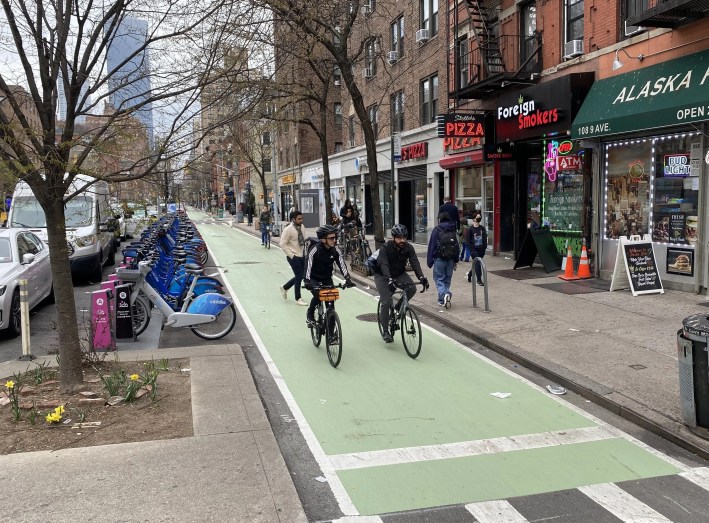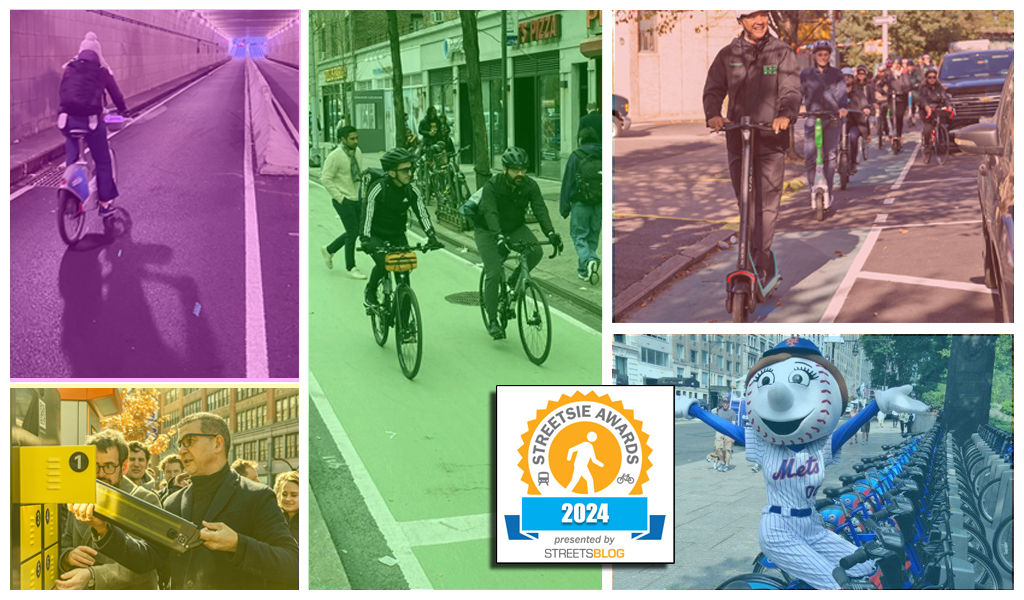
Just as we do every year, we throw out the old year and ring in the new one with our Streetsie Awards, a multi-post compendium of the best and worst projects, people, policies and politics of the year that was. If you want to read the entire series, it's archived here. Merry Christmas, Happy Hanukkah, a Joyous Kwanzaa and a Happy New Year to all.
This year was at best mixed bag for livable streets projects in New York City, with some important strides in the right direction, but an overall lack of ambition from an administration under fire for both corruption and zero vision for Vision Zero.
The Department of Transportation did, however, try out some interesting projects that acknowledged the need for better bike infrastructure, like wider and dedicated express paths, along with some hopeful infrastructure investments to make e-bike battery charging safer.
Some projects that had the potential to be marquee initiatives were hampered by City Hall interference, however, or simply didn't go as far as they should have.
It should not be lost on anyone that there are no bus improvement projects on this list, something Mayor Adams has repeatedly failed at miserably.
And the nominees are...
Wider and wider
The city's bike lanes are often no longer fit for purpose, as faster e-bikes and micromobility put the squeeze on paths painted more than a decade ago and measuring a mere four feet wide in places.
Last year and continuing in 2024, the city began installing some wider bike paths with more space for people to overtake or ride side-by-side, deploying lanes as wide as 10 feet.

The bigger green-painted spaces have arrived on busy bike corridors in Manhattan, including Ninth Avenue, 10th Avenue, Third Avenue, and Second Avenue.
The latest extension of Queens Boulevard also has more space, so hopefully this treatment will follow in more outer-borough corridors.
Today NYC DOT is celebrating the completion of the redesign of Queens Boulevard. This Vision Zero project is a powerful example of the effectiveness of engineering our streets for safety. Traffic deaths have declined by 68%; injuries by 35%; and pedestrian injuries by 45%.
— Vincent Barone ⛲️ (@vinbarone.bsky.social) 2024-11-12T18:19:13.387Z
E-scooter share in Queens
The city's e-scooter share program expanded from the Bronx to eastern Queens three years after launching in the Boogie Down in 2021, where DOT has since made the rollers a permanent feature.
The addition aims to fill in transportation gaps in parts of the boroughs with few fast and reliable mass transit options. The latest expansion covers the area roughly east of the Van Wyck Expressway around Flushing, Auburndale, Rochdale Village and Springfield Gardens.

The program has been successful, logging tens of thousands of accounts and nearly 300,000 rides, DOT has said, though parking the vehicles correctly was a problem a quarter of the time, the agency found early in its rollout in the Bronx.
Despite its popularity, some politicians in both boroughs have been throwing wrenches in the sustainable transportation mode, either urging the city pause or scrap it altogether. As the Old Man of 2024 is replaced by the New Year's Baby of 2025, it's unclear if the Adams administration will fight to keep its successful program or cave — and it's a shame we even have to wonder.
Taking 'charge' on batteries
Following a rash in fires fueled by lithium-ion batteries, the city focused on making it safer to recharge the power packs instead of punishing the roughly 75,000 delivery workers who rely on them for their e-bikes.
A DOT pilot for deliveristas sited safe charging hubs at five locations in Manhattan and Brooklyn, including charging kiosks for swapping empty battery with full ones, along with some docks that allow riders to plug in their bikes.

The stations turned out to be very popular, logging 12,100 battery swaps over the first six months, and the agency plans to expand to 53 locations near public housing complexes at some point in the future, thanks to $25 million in federal funding.
Tunnel vision
The city's first "express bike lane" opened in the First Avenue tunnel outside the United Nation's headquarters this year.
It's something the city had been implementing temporarily for five years during the global body's General Assembly each September, as officials rerouted car traffic as a security measure for the big confab.
DOT made those changes permanent this year by repurposing a car lane where the road that dips underground, between E. 40th and E. 49th streets.
The conversion spurred advocates to call on DOT to also open other redundant tunnels to cyclists, such as the Park Avenue ramp near Grand Central, which cyclists already got to enjoy during this year's Summer Streets.
Home run edition
The Mets had a good year, and we all know it was partly due to Citi Bike finally expanding to the similarly branded Citi Field, adding another climate-friendly and truly metropolitan option for getting to the game.
It's something we've been calling for in these pixels for years, but we'd be remiss if we didn't mention the need for DOT to actually make the streets leading out to the sports park safe, as our own Dave Colon documented in this Eyes On The Street report sprinkled with sports metaphors some members of the Streetsblog staff don't understand.
Honorable mentions
There were other projects that moved the needle, but others came with serious caveats and room for improvement.
More than a mile of 31st Avenue in Astoria got the bike boulevard treatment this year, adding a sorely-needed safe east-west corridor for cyclists in the western Queens neighborhood. The overhaul came in response to recent mobilization by Astorians — including via online forum Reddit — to bring safer street infrastructure to their neighborhood, which has lots of cyclists but few safe routes for them to get around.
The hard-fought McGuinness Boulevard road diet did finally happen, albeit not on the full corridor of the deadly Greenpoint road, as the Adams administration watered down the roughly northern third to appease powerful and politically-connected opponents in the area.
The decade-and-a-half transformation of Broadway with plazas and shared streets continued south to Union Square this year, extending the redesign from 21st Street to 17th Street.
The Washington Bridge between Manhattan and the Bronx finally opened its two-way bike lane this summer. The project repurposed two car lanes, one for the bike path and another for a bus lane on the other side of the span. The project followed successful bike lanes on the Brooklyn and Pulaski bridges, but was overshadowed by being a half a year behind schedule and too late for cyclist Zenaido Rosas-Pinzon, who was killed by a driver on the overpass not long before the protected path opened.
Finally, the Department of Sanitation began its first move to containerize residential waste in half a century this fall, requiring buildings with nine or fewer units to set out their trash in wheelie bins. The move is an upgrade from the piles of bags common around the Big Apple, but they continue to clutter the city's already narrow pedestrian space and still require Sanitation workers to lift bags out of the containers manually.
Now it's your chance to vote (if the ballot isn't below, refresh the page):






